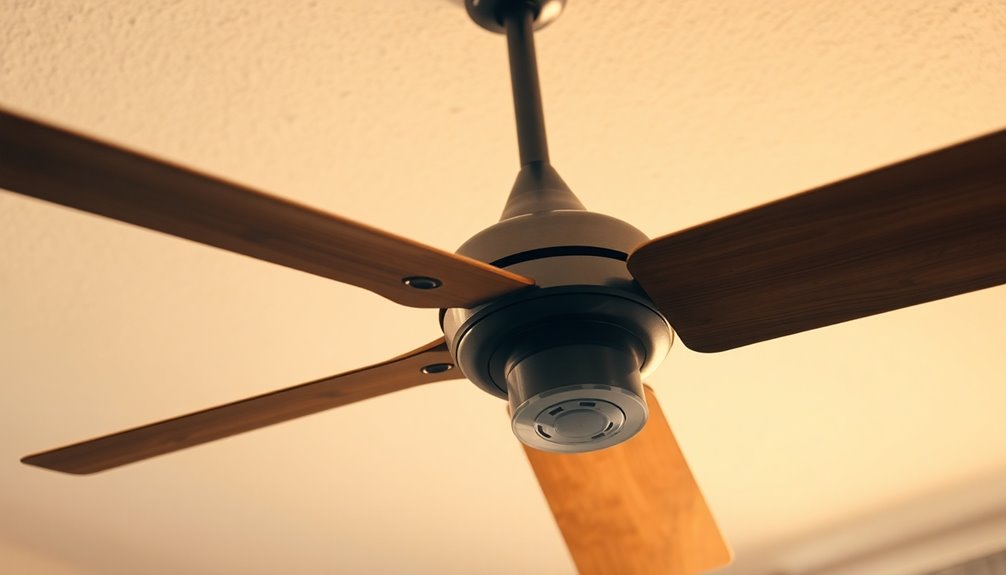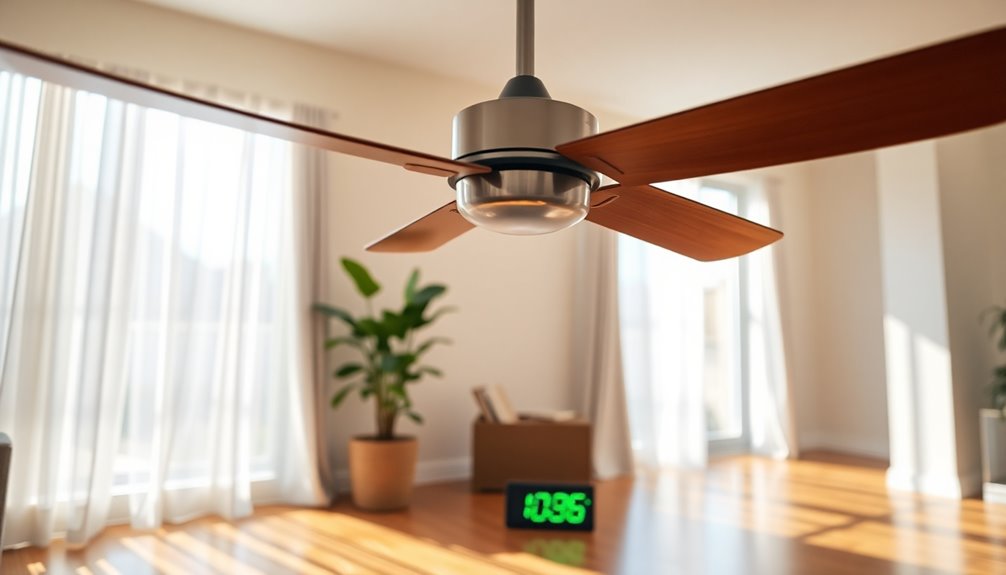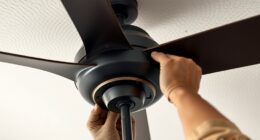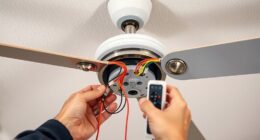Ceiling fans can wobble due to several issues. You might find loose screws or misaligned blades causing instability. Dust accumulation can add weight to the blades, worsening the wobbling. Environmental factors, like humidity, might warp the blades, too. If your fan's installation isn't secure, that could lead to excessive movement. Regular maintenance is essential; checking screws and cleaning blades can prevent these problems. If you're facing persistent wobbling despite your efforts, you might want to explore additional solutions or seek professional help to keep your fan running smoothly and effectively.
Key Takeaways
- Loose screws in the mounting or blade fixtures can cause instability and wobbling during operation.
- Misaligned or unevenly spaced blades disrupt airflow and create an imbalance, leading to wobbling.
- Dust accumulation on fan blades adds weight and can exacerbate wobbling issues.
- Warped blades from humidity or temperature changes can cause uneven rotation, contributing to wobbling.
- An incorrect ceiling box or mounting bracket can result in inadequate support, causing excessive movement and wobbling.
Causes of Ceiling Fan Wobbling
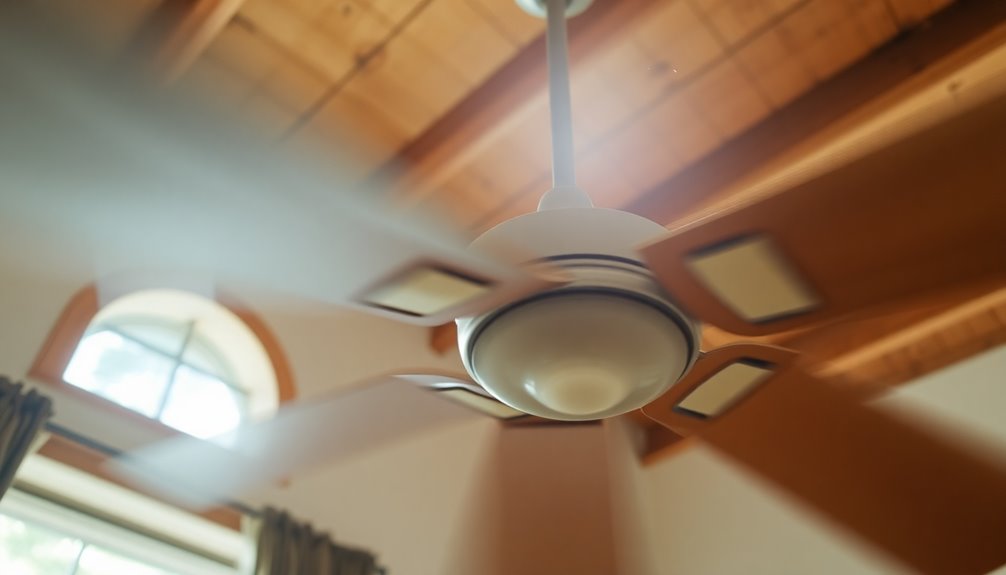
When it comes to ceiling fan wobbling, several factors can throw your fan off balance. A common culprit is loose screws. If the mounting screws or blade screws aren't tight, your fan can become a wobbly ceiling fan, making it not only annoying but potentially damaging over time.
Another important factor is blade balancing. If your fan blades are misaligned or unevenly spaced, they can create an imbalance, leading to wobbling during operation. Additionally, dust and dirt accumulation on one side of the blades can add extra weight, exacerbating the issue.
Environmental factors also play a role. Changes in humidity and temperature can warp the blades, further disrupting their balance.
Regular maintenance is essential to prevent such problems. Cleaning your fan regularly and checking for tightness of screws helps maintain blade balancing and enhances overall performance.
Ignoring these causes can result in a persistent wobbly ceiling fan, which can eventually lead to more significant issues. By staying proactive with maintenance and addressing these factors, you can enjoy smooth, quiet operation from your ceiling fan for years to come.
Common Installation Mistakes
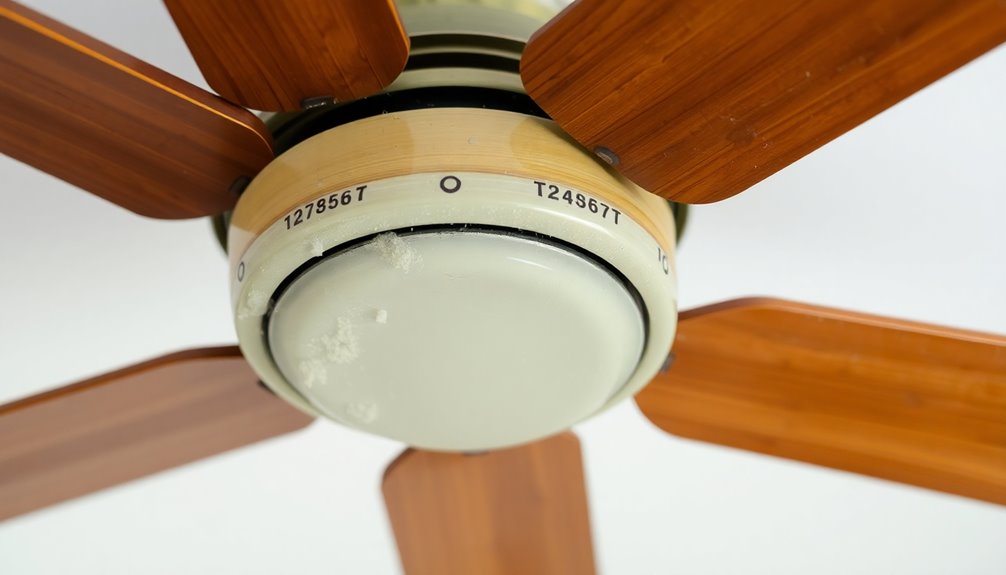
When installing your ceiling fan, a few common mistakes can lead to frustrating wobbling.
If you don't use a ceiling box that's rated for fan support or neglect to secure the mounting bracket properly, you're setting yourself up for instability.
Also, verify that all blades are even; uneven installation can create an imbalance that makes your fan shake.
Incorrect Ceiling Box Support
Proper support is crucial for a ceiling fan's stability and performance. An incorrectly installed ceiling fan can wobble considerably if it's not anchored properly. A non-fan rated ceiling box often lacks the strength needed to secure the fan, leading to instability. If the mounting bracket isn't tightly secured to the ceiling box, you'll notice excessive movement during operation.
Additionally, if the fan's mounting plate isn't aligned with the ceiling box, it can create uneven weight distribution, further exacerbating wobbling issues. Fans should also be installed with a minimum clearance of 8-9 feet from the floor to guarantee maximum performance. High-end brands often utilize advanced technology to ensure stability and minimize wobbling.
Here's a quick reference table to help you understand key factors affecting ceiling fan support:
| Factor | Importance |
|---|---|
| Ceiling Box | Must be fan-rated for proper support |
| Mounting Bracket | Must be securely fastened to prevent wobbling |
| Alignment | Proper alignment guarantees even weight distribution |
| Installation Height | Minimum 8-9 feet for maximum airflow
Uneven Blade Installation
An improperly mounted ceiling fan might wobble, but uneven blade installation can amplify those issues greatly. When you install fan blades at different heights, you create an imbalance that leads to a wobbly ceiling fixture during operation.
If you don't tighten the screws securing the blades to the blade holder uniformly, varying blade tension can result in misalignment, further exacerbating the wobbling. Additionally, if the blades aren't installed at the correct angles or aren't parallel to the ceiling, this instability can manifest at different speeds, making the wobbling even more pronounced.
You mightn't realize that dust accumulation on one side of the fan blades can also contribute to this problem. The added weight disrupts the fan's balance, making uneven blade installation even more problematic.
To prevent these issues, carefully follow the manufacturer's guidelines for blade installation. Confirm that all blades are evenly spaced and secured tightly.
Loose Mounting Bracket
A loose mounting bracket is one of the most common mistakes that can lead to a wobbly ceiling fan. When the mounting bracket isn't securely fastened, it fails to hold the fan body in place, which directly affects its stability during operation.
Ensuring that all screws are tightly fastened to the ceiling junction box is essential. Here are some key points to keep in mind:
- Most ceiling fans require at least three screws for proper installation.
- Neglecting to tighten all the screws can cause instability and wobbling.
- Install the mounting bracket on a ceiling box rated for fan support.
- A loose mounting bracket can develop over time, so regular inspections are necessary.
- Proper alignment during installation is critical to prevent future issues.
Importance of Regular Maintenance

Over time, regular maintenance of your ceiling fan becomes essential for peak performance and longevity. By routinely checking the balance and inspecting the fan blades, you can prevent dust accumulation that can lead to wobbling. Establishing a maintenance schedule, like once a year, allows you to address minor issues promptly, which can prevent more significant problems down the line.
Using a blade balancing kit during your maintenance checks guarantees stability, promoting a smooth and efficient workflow for your fan.
| Maintenance Task | Frequency |
|---|---|
| Clean fan blades | Every 3 months |
| Check screw tightness | Every 6 months |
| Use blade balancing kit | Once a year |
Tools for Fixing Wobble
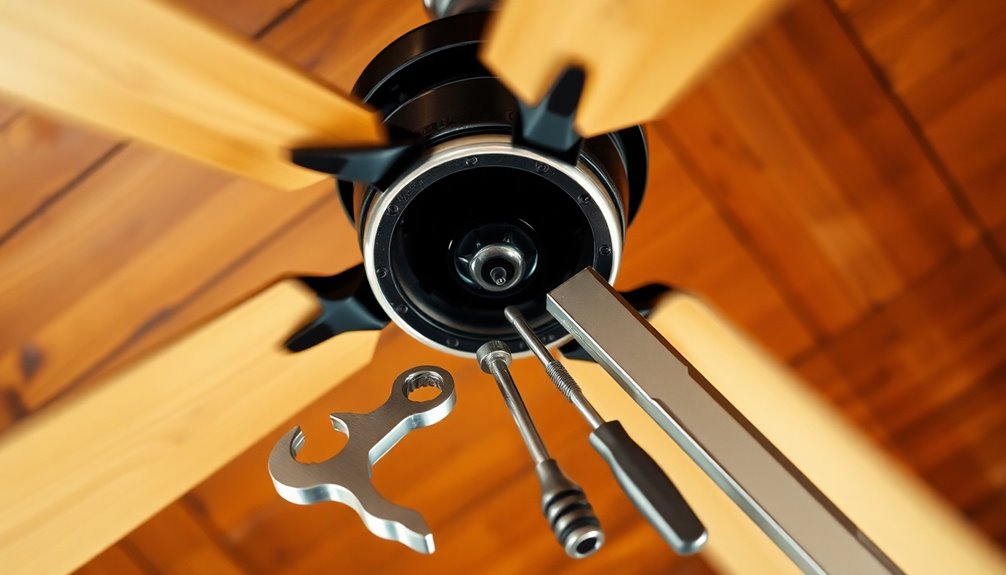
To fix a wobbly ceiling fan, you'll need some essential tools on hand.
A ladder or step stool lets you access the fan safely, while a screwdriver helps tighten any loose screws.
Additionally, having a ceiling fan balancing kit can assist in adjusting weight distribution for a smoother operation.
Essential Tools Required
When tackling a wobbly ceiling fan, gathering essential tools can make the process smooth and efficient.
You'll want to have the right equipment on hand to guarantee you can inspect and repair your fan effectively.
Here's a list of must-have tools for the job:
- Ladder: A sturdy ladder or step stool is vital for safely reaching your ceiling fan during inspection and repair.
- Screwdriver: You'll need a reliable screwdriver to tighten any loose screws on the fan blades and mounting bracket.
- Tape Measure: Having a tape measure handy allows you to check the clearance of the blades from nearby objects, which can affect balance.
- Duster: Use a duster or clean cloth to remove dust from the fan blades, as this can help maintain their balance and performance.
- Ceiling Fan Balancing Kit: This kit contains clips and adhesive weights that are useful for adjusting the weight distribution of the blades to correct wobbling.
With these tools, you'll be well-equipped to address any issues with your ceiling fan and restore its stability.
Maintenance and Balancing Kits
Regular maintenance plays a key role in preventing ceiling fan wobble, and incorporating a balancing kit can enhance your efforts. Start by regularly cleaning dust from the fan blades, which helps maintain balance and reduces excess weight on one side.
A ceiling fan balancing kit typically includes clips and adhesive weights, designed to identify and correct imbalances effectively. To use the balancing kit, attach a clip to the end of a blade and run the fan to see which blade causes the wobbliness. Once identified, apply the adhesive weights to that blade for a more permanent solution. This simple process can considerably reduce or eliminate the wobbly motion.
Additionally, make sure to inspect and tighten screws on both the fan blades and the mounting bracket. This regular maintenance guarantees stability and can prevent future wobbling.
Don't forget to have tools on hand like a ladder or step stool for safe access, a screwdriver for any adjustments, and a tape measure to check the clearance from blades to surrounding objects. Keeping your ceiling fan in good shape not only improves its performance but also extends its lifespan.
Step-by-Step Fixing Guide
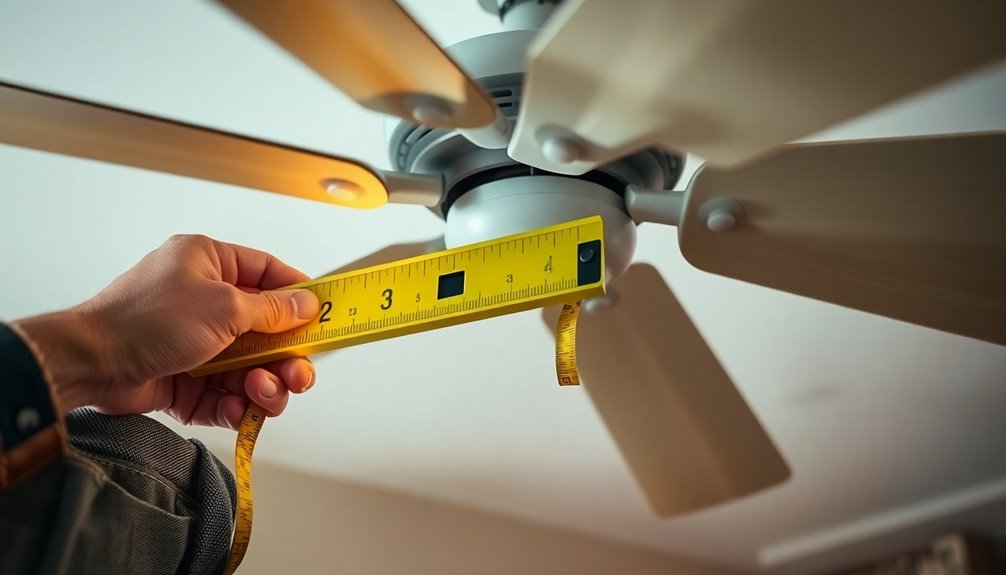
A few simple steps can help you fix a wobbly ceiling fan and restore its smooth operation. Start by ensuring that all fan blades are tightly secured to their holders. Loose screws can lead to significant wobbling issues.
Next, measure the distance between the blades and the ceiling using a yardstick to confirm uniformity; any discrepancies may require adjustments.
Follow these steps for an effective fix:
- Check and tighten all blade screws.
- Use a ceiling fan balancing kit to identify wobbling causes.
- Clean the fan blades to remove dust and debris.
- Inspect the mounting bracket and ceiling box for stability.
- Adjust blade angles if necessary to maintain balance.
If wobbling persists after these adjustments, it's crucial to inspect the mounting bracket and ceiling box for any stability issues.
A well-balanced ceiling fan not only operates smoothly but also enhances your room's comfort. By following this guide, you can effectively tackle any wobbly fan, ensuring it runs quietly and efficiently, eliminating the annoyance of wobbling once and for all.
When to Seek Professional Help
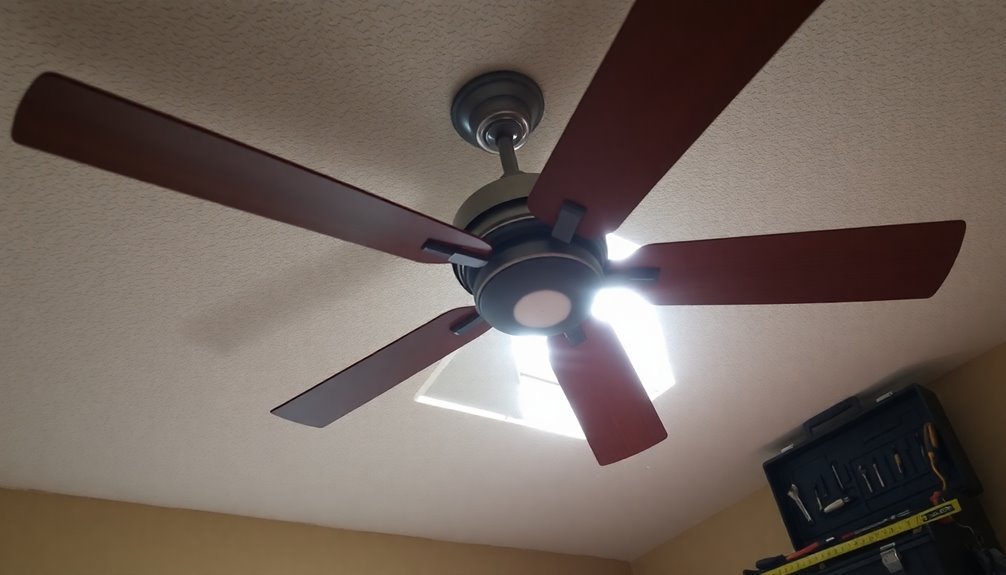
Sometimes, despite your best efforts to fix a wobbly ceiling fan, it just won't cooperate. If you've cleaned, tightened screws, and balanced the blades with no success, it's time to contemplate a professional assessment.
Persistent wobbling could indicate deeper issues like warped blades or a faulty motor, which are best diagnosed by a qualified technician.
If you notice unusual noises or vibrations accompanying the wobble, that could signal a mechanical failure. Ignoring these signs might lead to further damage, so it's wise to contact an expert.
Additionally, if your fan is installed on a non-fan rated ceiling box, you may face ongoing instability that requires professional installation to guarantee safety and stability.
Regular maintenance is essential for keeping your ceiling fan in top shape. If you're unable or unwilling to perform routine checks and repairs, enlisting professional help can safeguard your investment. A technician can provide the necessary upkeep to prolong your ceiling fan's life and functionality, allowing you to enjoy a cool breeze without worry.
Furthermore, understanding energy-efficient models can help you choose a ceiling fan that minimizes electricity costs while maximizing performance.
Don't hesitate to reach out when the situation calls for it.
Frequently Asked Questions
How Do I Stop My Ceiling Fan From Wobbling?
To stop your ceiling fan from wobbling, start by checking that all blades are securely fastened and that there are no loose screws.
Measure the distance between the blades and the ceiling to guarantee they're even.
Clean the blades regularly to avoid dust buildup.
If wobbling persists, use a balancing kit to add weights as needed.
Finally, inspect the mounting bracket and ceiling box for tightness to guarantee a stable installation.
How to Know if a Ceiling Fan Will Fall?
You might enjoy the cool breeze from your ceiling fan, but what if it suddenly falls?
To know if it's at risk, check for a wobble or unusual noises like grinding. If it shakes when you give it a gentle push, that's a red flag.
Confirm the mounting screws are tight and inspect the fan regularly. A little maintenance can save you from a precarious situation, turning worry into peace of mind.
How Do You Rebalance a Ceiling Fan?
To rebalance your ceiling fan, start by checking that all blades are securely attached and free from dust.
Next, use a balancing kit to identify imbalances, testing different blade positions. Measure the distance between each blade and the ceiling for uniform spacing.
If you find misaligned blades, gently bend the blade holder or swap opposite blades.
After each adjustment, run the fan at various speeds to ascertain stability, repeating as needed until it's balanced.
How Do I Stop a Fan From Moving Side to Side?
Imagine a ship swaying at sea, struggling against the waves. To stabilize it, you'd check the sails and verify everything's secure.
Similarly, to stop your fan from moving side to side, start by tightening all screws on the blades and checking their alignment. Dust can weigh one side down, so keep those blades clean.
Finally, verify the mounting bracket's secure for a sturdy foundation, just like a ship needs a solid hull.
Conclusion
In the dance of air, a wobbling ceiling fan can disrupt the harmony of your space. By understanding the causes, addressing installation missteps, and committing to regular maintenance, you can restore balance to your room's atmosphere. Armed with the right tools and a step-by-step approach, you're well-equipped to tackle the issue. Yet, if the fan's sway persists like an uninvited guest, don't hesitate to call in the professionals for a graceful resolution.
